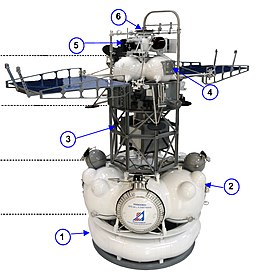 Yinghuo-1 marked label 3 | |
| Mission type | Mars orbiter |
|---|---|
| Operator | CNSA |
| Mission duration | 1 year in Mars orbit (planned) Never departed Earth orbit |
| Spacecraft properties | |
| Launch mass | 115 kilograms (254 lb)[1] |
| Dimensions | 750mm x 750mm x 650mm (stowed)[1] |
| Power | 90 W, solar array |
| Start of mission | |
| Launch date | 8 November 2011, 20:16:03 UTC[2][3][4] |
| Rocket | Zenit-2M |
| Launch site | Baikonur 45/1 |
| Deployed from | Fobos-Grunt (planned) |
| End of mission | |
| Decay date | 15 January 2012[5] |
| Orbital parameters | |
| Reference system | Areocentric (planned) Geocentric (achieved) |
| Regime | Low Earth (achieved) |
| Perigee altitude | 800 kilometres (500 mi) (planned) |
| Apogee altitude | 80,000 kilometres (50,000 mi) (planned) |
| Inclination | 5 degrees (planned) |
| Period | 3 days (planned) |
Yinghuo-1 (simplified Chinese: 萤火一号; traditional Chinese: 螢火一號; pinyin: Yínghuǒ yī hào) was a Chinese Mars-exploration space probe, intended to be the first Chinese planetary space probe and the first Chinese spacecraft to orbit Mars. It was launched from Baikonur Cosmodrome, Kazakhstan, on 8 November 2011, along with the Russian Fobos-Grunt sample return spacecraft, which was intended to visit Mars' moon Phobos.[2][6] The 115-kg (250-lb) Yinghuo-1 probe was intended by the CNSA to orbit Mars for about two years,[1] studying the planet's surface, atmosphere, ionosphere and magnetic field.[citation needed] Shortly after launch, Fobos-Grunt was expected to perform two burns to depart Earth orbit bound for Mars. However, these burns did not take place, leaving both probes stranded in orbit.[7] On 17 November 2011, CNSA reported that Yinghuo-1 had been declared lost.[8] After a period of orbital decay, Yinghuo-1 and Fobos-Grunt underwent destructive re-entry on 15 January 2012, finally disintegrating over the Pacific Ocean.[5][9]
As a result, CNSA subsequently moved to embark on an independent Mars exploration program, which culminated in the Tianwen-1 orbiter-lander-rover mission that successfully landed the Zhurong rover on Mars on 22 May, 2021.[10]
- ^ a b c Lakdawalla, Emily (9 September 2010). "China's Yinghuo-1 Mars Orbiter". The Planetary Society. Archived from the original on 1 April 2012. Retrieved 30 May 2011.
- ^ a b "Russia takes aim at Phobos". Nature.com. 4 November 2011. Retrieved 24 April 2013.
- ^ Запуск станции "Фобос-Грунт" к спутнику Марса отложен до 2011 года (in Russian). РИА Новости. 21 September 2009. Retrieved 21 September 2009.
- ^ "Solar System Exploration". Archived from the original on 14 June 2011. Retrieved 12 December 2009.
- ^ a b "Phobos-Grunt: Failed Russian Mars Probe Falls to Earth". ABC News, 15 January 2012.
- ^ "Daring Russian sample return mission to Martian moon Phobos aims for November Liftoff". Universe Today, 2011-10-13. Retrieved 17 October 2011.
- ^ Маршевая двигательная установка станции "Фобос-Грунт" не сработала (in Russian). RIA Novosti. 9 November 2011. Retrieved 20 November 2011.
- ^ "Yinghuo Was Worth It". Space Daily, Morris Jones, 17 November 2011. Retrieved 19 November 2011.
- ^ "Phobos-Grunt: Failed probe likely to return late Sunday". BBC News, 15 January 2012.
- ^ Myers, Steven Lee; Chang, Kenneth (14 May 2021). "China's Mars Rover Mission Lands on the Red Planet". The New York Times. Retrieved 16 May 2021.